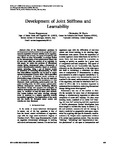Development of joint stiffness and learnability
| dc.contributor.author | Kuppuswamy, N | |
| dc.contributor.author | Harris, Chris | |
| dc.date.accessioned | 2017-10-10T13:14:44Z | |
| dc.date.available | 2017-10-10T13:14:44Z | |
| dc.date.issued | 2014-10 | |
| dc.identifier.isbn | 9781479975402 | |
| dc.identifier.issn | 2161-9484 | |
| dc.identifier.uri | http://hdl.handle.net/10026.1/10037 | |
| dc.description.abstract |
One of the fundamental problems in developmental robotics relates to the progressive spontaneous acquisition of motor abilities by an organism. Throughout this process, the speed of acquiring abilities, which we term 'learnability', is strongly limited by the dimensionality of the sensori-motor space; this in turn could affect the survival of an organism. In this paper, we tackle the problem of dimensional change during development using a framework of control dimensionality reduction based on nonlinear system balancing. Using a set of internal models of behaviour of increasing dimensionality, we show that joint-stiffness regulation can be used to ensure optimal development of motor skills. This is quantified as a maximisation of internal model accuracy at intermediate stages of learning. We test our approach in a simulation of a human arm modelled as a 2 link kinematic chain performing point-to-point and via-point reaching tasks. We then analyse optimal joint-stiffness development towards facilitating effective dimensional change and compare two strategies, (i) uniform development and (ii) proximo-distal development, i.e. variation of only the distal joint stiffness. Our results indicate that latter strategy, although lower in accuracy is a simpler approach towards learnability regulation. The implications of the model and the results for biological motor control and robotics are then discussed. | |
| dc.format.extent | 408-414 | |
| dc.language.iso | en | |
| dc.publisher | IEEE | |
| dc.subject | Bioengineering | |
| dc.title | Development of joint stiffness and learnability | |
| dc.type | conference | |
| dc.type | Conference Proceeding | |
| plymouth.author-url | https://www.webofscience.com/api/gateway?GWVersion=2&SrcApp=PARTNER_APP&SrcAuth=LinksAMR&KeyUT=WOS:000412232300072&DestLinkType=FullRecord&DestApp=ALL_WOS&UsrCustomerID=11bb513d99f797142bcfeffcc58ea008 | |
| plymouth.date-start | 2014-10-13 | |
| plymouth.date-finish | 2014-10-16 | |
| plymouth.conference-name | 2014 Joint IEEE International Conferences on Development and Learning and Epigenetic Robotics (ICDL-Epirob) | |
| plymouth.publication-status | Published | |
| plymouth.journal | 4th International Conference on Development and Learning and on Epigenetic Robotics | |
| dc.identifier.doi | 10.1109/devlrn.2014.6983016 | |
| plymouth.organisational-group | /Plymouth | |
| plymouth.organisational-group | /Plymouth/Faculty of Health | |
| plymouth.organisational-group | /Plymouth/Research Groups | |
| plymouth.organisational-group | /Plymouth/Research Groups/Centre for Brain, Cognition and Behaviour (CBCB) | |
| plymouth.organisational-group | /Plymouth/Research Groups/Centre for Brain, Cognition and Behaviour (CBCB)/Brain | |
| plymouth.organisational-group | /Plymouth/Users by role | |
| dc.rights.embargoperiod | Not known | |
| rioxxterms.versionofrecord | 10.1109/devlrn.2014.6983016 | |
| rioxxterms.licenseref.uri | http://www.rioxx.net/licenses/all-rights-reserved | |
| rioxxterms.type | Conference Paper/Proceeding/Abstract |


